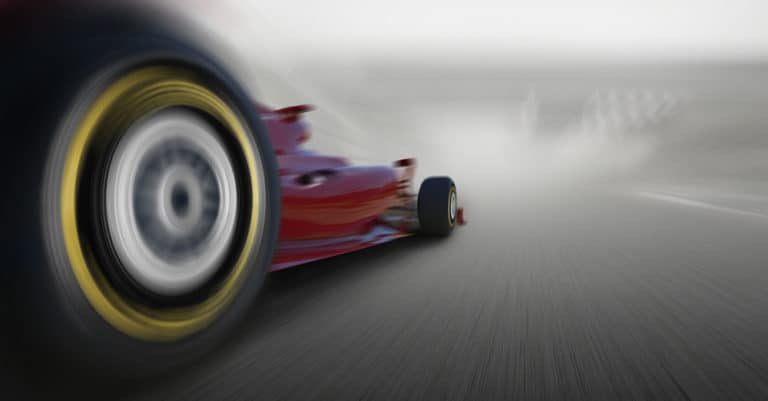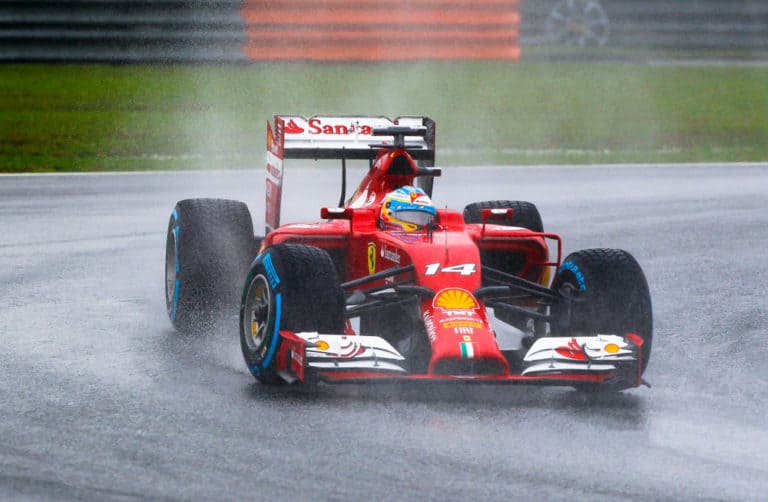Since my first years as an F1 fan, I have seen many great drivers like Michael Schumacher, Fernando Alonso, Lewis Hamilton, or Kimi Raikkonen, all of them men. I don’t recall seeing any women, but why are there no female drivers in F1?
There are only 20 seats available in F1, and thousands of young drivers try to enter. Hardly anyone gets in, so it’s challenging to do so. As women only make up 2% in motorsport, according to statistics, the chances of any of them making it are very slim.
Since its inception, racing has been a male-dominated sport, and women haven’t had much of a chance. This is a fascinating topic that there is a lot to talk about, so read on to find out everything!
If you’re looking for some F1 merchandise, check out the awesome stuff at the official F1 store here.
Can Women Become F1 Drivers?
F1 is the pinnacle of racing, where (in theory) the fastest drivers in the world take part in the quest to be the best of the best. On paper, no rule doesn’t allow women to compete in F1 or any FIA or motorsports competition.
Unlike most other sports, motorsports do not have men’s and women’s divisions, which means that both can compete together. In motor racing, physical ability is not everything, but a large part depends on the car, so the genetic differences between the sexes are not as pronounced as in other sports.
This offers, in principle, equal conditions for both men and women to run, but as we will see below, it has not been fulfilled in reality.
Why Are There No Female Drivers In F1?
Although there is inclusion and equal conditions for both sexes on paper, in practice, Formula 1 and motorsports, in general, have been and continue to be sports dominated by men. This has meant that for much of the 20th century, F1 has been considered a men’s sport, so women simply have not had many opportunities to race.
And although this is changing in recent decades, as female inclusion is promoted, the ratio of men to women entering racing in junior categories is heavily skewed in one direction. It is estimated that the ratio is 98 to 2 in favor of men, so it is tough for any of the 2% women to reach F1 since the competition is very high.
As there are only 20 seats available, even as a man, the chances to reach F1 are extremely low, so representing only 2% of the total, they are even lower. By statistics, it is logical that women do not reach Formula 1, but the reasons can be much more complex.
First of all, there are still fewer girls interested in motorsports, either by nature or because society does not encourage them enough, or maybe both, which would give for another debate.
Of this percentage, women tend to perform better in lower categories such as karting, but the number drops dramatically as they get closer to F1. And although, as we said before, it has to do with statistics, many experts wonder if the physical also plays an important role.
In categories such as Formula 3, Formula 2, or the World Series, unlike Formula 1, there is no power steering, so the steering wheels are extremely hard, and you have to have a physical preparation that not even all men can have, so this could be a handicap for women.
Due to this, there is a diversity of opinions, as there are those who think that this is a determining reason why women cannot progress while others think that with the training, they can replace the 30% less muscle mass they have. Be that as it may, it is clear that it is not a fact in favor.
Later we will see the initiatives of the FIA to promote the inclusion of women in motorsport and if there is still hope of seeing any women in F1.
Has There Ever Been A Female F1 Driver?
Although with what we have seen previously, it may not seem like it, there have been women who have raced in Formula 1. Since 1950, 5 women have entered a Grand Prix, of which only 2 managed to qualify for a race. These are the women who have competed in F1:
- Maria Teresa de Filippis (1958-1959)
- Lella Lombardi (1974-1976)
- Divina Galica (1976-1978)
- Desiré Wilson (1980)
- Giovanna Amati (1992)
Italian Maria Teresa de Filippis was the first woman to race in Formula 1. She entered five races in the 1958 and 1959 seasons and started three, scoring a best result of the tenth position in the 1958 Belgian GP.
He had to face a lot of criticism and adversity, so his career was not easy. At the 1958 French GP, the race director said: “the only helmet a woman should use is the hairdresser’s.” The next woman to compete in F1 was fellow Italian Lella Lombardi, who entered 17 races and qualified for 12 between 1974 and 1976.
Lella Lombardi is the most successful woman to have raced in F1, as she is the only one to have scored points when she came sixth in the 1975 Spanish GP. The race was stopped before three-quarters of the scheduled race distance was completed, so only half points were awarded, and Lombardi got half a point.
British Divina Galica was the next woman to race in F1, entering 3 races, although she failed to qualify for any of them. Her first attempt was at the 1976 British GP, the only F1 Grand Prix in which more than one woman, Lombardi, and Galica, entered, but both failed to qualify for the race.
South African Desiré Wilson entered a race in 1980, although she did not qualify, and Italian Giovanna Amati trained in 3 races in 1992, although she also failed to qualify for any.
In 1979, Desiré Wilson won an Aurora Formula One Series race. This British category used old F1 cars, the most important victory of a woman in a formula car race until Danica Patrick’s victory in the Indy Cars at the 2008 Japanese GP.
Have There Been Any Female Drivers In F1 In Recent Years?
Despite the fact that since 1992 with Giovanna Amati, there has been no woman who has entered a GP, we have seen a proliferation of women in the lower categories and a greater number of them associated with F1 teams. In recent years there has been an increased number of female test and development drivers who have driven F1 cars and helped the teams.
In 2002, IndyCar driver Sarah Fisher performed a demonstration run with McLaren after first practice for the 2002 US Grand Prix, and in 2005, Katherine Legge tested with Minardi at the Vallelunga Circuit.
In 2012, the Spanish driver María de Villota, daughter of former F1 driver Emilio de Villota, worked as a development driver for Marussia in 2012, the year in which she had an accident with an F1 during a test at Duxford aerodrome, and unfortunately passed away a year later due to the aftermath of her accident.
In 2014, IndyCar driver Simona Silvestro worked as a Sauber-affiliated driver for a few months. The Spanish Carmen Jordá signed with Lotus Renault as a development driver for 2015 and 2016. The Colombian Tatiana Calderón worked as a Sauber development driver between 2017 and 2019, the first Latin American woman to drive an F1 car.
However, the one who has stood out the most has been the British Susie Wolff, Toto Wolff’s wife, as she has been the only one who has participated in official tests of a Grand Prix. She was a test driver for Williams from 2012 to 2015.
In 2014, Wolff took part in two free practice sessions at the British and German GP. At the British GP, he was only able to complete one lap due to engine problems, but at the German GP, he did complete more laps, finishing the session in 15th place out of 22 cars, just two-tenths of a second behind teammate Felipe Massa.
Currently, the double W Series world champion in 2019 and 2021, Jamie Chadwick, has worked as a development driver for the Williams team since 2019. In addition, Chadwick is the only woman to have won a British Formula 3 race in 2018. Chadwick is currently the greatest female exponent in motorsport.

What Is W Series?
The W Series is an all-female championship that the FIA announced in 2018 as a response to the lack of female representation in the highest categories of motorsport and encourages women and girls to enter the world of racing. The W Series selects its drivers based solely on speed, fitness, and potential, and unlike other racing series, drivers do not have to pay an entry fee or have any financial backing.
The W Series uses identical Formula 3 cars for all drivers, powered by Alfa Romeo, and the championship is made up of 18 female racers. 2019 was the first season, in which there were 6 races. The 2020 season was canceled due to the Covid-19 pandemic, with the championship returning in 2021 with 8 races. The champion of both years, as we mentioned before, was the British Jamie Chadwick.
All 6 races from 2019 were run in Europe in support of the 2019 DTM: Hockenheimring, Zolder, Misano, Norisring, Assen, and Brands Hatch.
However, this championship has not been without criticism, as many public figures argued that this category, instead of promoting female inclusion in the established series, will segregate female runners. The 2021 season was run in support of the 2021 F1 World Championship: Red Bull Ring (2 races), Silverstone, Hungaroring, Spa-Francorchamps, Zaandovrt, and the Circuit of the Americas (2 races).
The opponents of the W Series claim that motorsport has never segregated drivers based on race, age, sexual orientation, or gender since it is about being the best without any of that mattering. This category would establish segregation of gender. Figures like Pippa Mann, Charlie Martin, Simona de Silvestro, and Claire Williams have shown their disagreement with the championship.
Will There Be A Woman In F1 Again Anytime Soon?
More women than ever are now one step closer to the top tiers of motorsport, and great strides in visibility have been made in recent years. F1 teams are increasingly working to promote female inclusion, as Ferrari did in 2020, announcing that it was looking to add female drivers into the ranks of its Ferrari Driver Academy.
However, the percentage of women in racing is still low, so it is somewhat difficult for any woman to enter F1 soon, although we have to be optimistic about the next decade. What needs to be done is to encourage participation and create opportunities for all, including women.
We need to ensure that girls know that motorsports are an option. It is logical that if there are few exponents of the female sex, the possibility that a girl notices motorsports is less, but with exponents such as Jamie Chadwick or Sussie Wolff, we hope that a virtuous circle will be created in which more and more women participate in motorsports and more girls notice them.
Conclusion
Even though Formula 1 has been a sport dominated by men since its inception in 1950, there have been female fighters who have tried to leave their mark on the category and who have become true exponents and role models.
There are now more women than ever racing, and female participation should be encouraged but not forced so that girls know that they too can be part of motorsports.
Sources
- https://www.sportskeeda.com/f1/why-arent-there-any-women-formula-one-racers
- https://thehumanraceblog.com/2021/03/07/why-are-there-no-female-f1-drivers/
- https://www.youtube.com/watch?v=yW7K3usSzPc
- https://as.com/motor/2017/11/05/formula_1/1509899919_448681.html
- https://en.wikipedia.org/wiki/List_of_female_Formula_One_drivers
- https://en.wikipedia.org/wiki/Susie_Wolff#Formula_One
- https://www.eurosport.co.uk/formula-1/when-will-a-woman-race-in-f1-again_sto4846981/story.shtml






